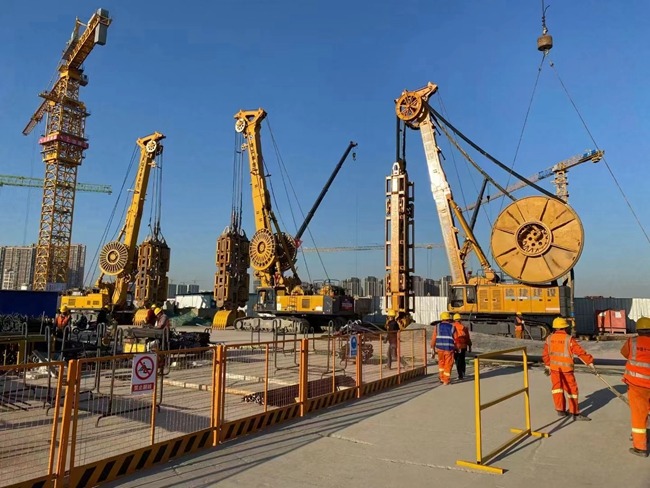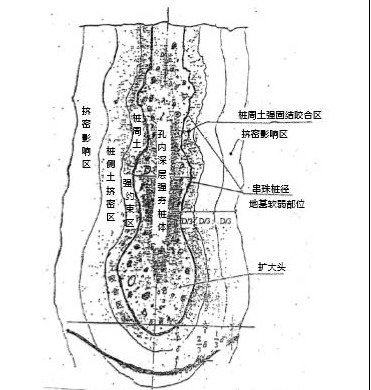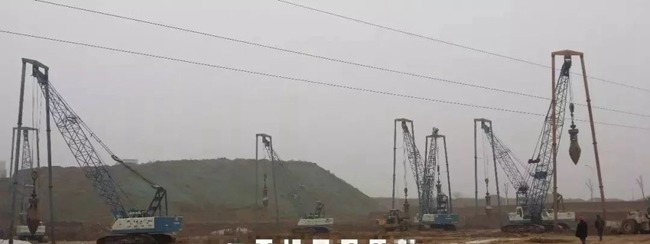Foundation engineering is an extremely important part of construction projects, whether it is the treatment of problems such as “miscellaneous filling”, “weakness”, “collapse”, “liquefaction” and “expansion”, or the problems of “corrosive media” and “groundwater” The processing of difficult foundations such as “large-thickness” construction waste and high-fill stones all present very thorny problems to varying degrees. Often due to the particularity of foundation projects and defects in treatment methods, not only does it cause huge economic waste to the project, but it also brings hidden dangers to the safety of the project. Inorganic solid pollutants (soil, broken bricks, stones, sand, industrial waste, construction waste, and their mixtures, dust, etc.) in current environmental protection projects have caused serious harm to society. With the development of social construction, this problem will become more and more serious, polluting rivers and bays, cities and rural areas, and blocking roads and rivers.
In-Hole Deep Compaction Method DDC
Basic principles of construction methods
Down-hole dynamic consolidation is a deep foundation treatment method. This method first forms holes to a predetermined depth, and then performs dynamic compaction with layered filling from bottom to top or dynamic compaction while filling to form dense pile bodies with high bearing capacity and strongly compacted soil between piles (hereinafter referred to as the DDC method).
The ballast soil pile composite foundation refers to using construction waste, miscellaneous soil, plain soil, stone, lime soil, non-toxic industrial waste, and their mixtures as fillers to form a composite foundation with high bearing capacity using the DDC method.
Scope of application of DDC construction method The DDC method is suitable for the treatment of plain fill soil, mixed fill soil, sand soil, silt soil, clay soil, collapsible loess, silty soil, and other foundations.
The foundation treated by the DDC method should use plain soil, sand, gravel, construction solid waste, industrial waste, lime soil, concrete, and other non-corrosive mixtures and materials that do not pollute groundwater as pile fillers.
When dealing with various types of weak foundations, the DDC method uses dynamic consolidation as a means and uses inorganic materials, such as inorganic and non-toxic solid soil, sand, stone, broken bricks, industrial waste, and their mixtures, as fillers to save steel, Cement reduces costs, saves cultivated land, protects the ecological environment, and has the characteristics of green engineering technology effects. In addition to the application ranges listed above, it has obvious effects on the treatment of deserts, garbage dumps, and industrial waste dumps.
DDC construction method technical characteristics
The DDC method is to use machines to form holes (drilling or punching), and then fill the deep parts of the foundation through the holes, and use a special gravity rammer with high kinetic energy to punch, smash, and squeeze with high-pressure and strong squeezing. The ramming operation can achieve the purpose of strengthening the foundation, absorbing garbage and ballast soil, and significantly improving the load-bearing capacity of the foundation. This is a distinctive building foundation treatment method that is not available in general foundation treatment technologies.
Compared with the dynamic compaction method, the DDC method uses a special heavy hammer for compaction operations. Since the diameter of the pile hammer is small, it can generate high-pressure and strong kinetic energy of thousands of kN·m/m2. Therefore, under the same rammer weight and falling distance conditions, DDC The compaction energy per unit area of the method is much greater than that of the strong compaction method. During construction, layers of fillers are layered in the hole from deep to shallow, and the layers are strongly rammed or filled and rammed at the same time. Therefore, this method has high kinetic energy, high pressure, and a strong squeezing effect. Directly reinforce the weak underlying layer in the deep layer and uniformly reinforce the foundation from bottom to top, up to a maximum depth of 30m, while the effective depth of the dynamic compaction method is generally only about 10m. In addition, the DDC method pile hammer is divided into a pointed cone-rod shape or an olive shape, which is much better than a flat hammer during ramming. During ramming, the lower layer of filler is subjected to deep dynamic tamping, smashing, and compaction, while the upper layer of new filler is subjected to dynamic ramming, smashing, splitting, and forced lateral extrusion. Through the dynamic ramming of the pile hammer, a huge dynamic passive earth pressure is generated on the side of the hammer. The hammer pushes the soil and forces the filler to be extruded to the periphery, and the soil between the piles is also strongly compacted and reinforced. Furthermore, the foundation treated by the DDC method is reinforced from top to bottom and is in a uniform and dense state. However, the foundation reinforced by dynamic compaction is strong at the top and weak at the bottom. If there is a weak underlying layer, the purpose of foundation reinforcement will not be achieved. In short, the compactness and uniformity of the foundation treated by the DDC method are good, the ramming energy is high, and the reinforcement depth is large; while the pile hammer weighs less than the strong ramming hammer, has lower requirements for machinery and tools, and produces less pollution. The tamping method has great advantages.
Compared with flexible reinforced piles, the DDC method uses a heavier rammer when reinforcing the foundation. The reinforcement material in the hole is subject to high kinetic energy and strong ramming per unit area, causing the foundation soil to be subject to high pre-compression stress. The treated foundation is soaked in water. There will be no obvious compression deformation or loading, and the bearing capacity of the foundation can be increased by 3 to 9 times. The maximum processing depth can reach 30m. Moreover, the soil between the piles is also subject to a large lateral compression force and is also compacted and reinforced. The soil around the pile is compacted to form a forced compaction zone, a compaction zone, and a compaction-affected zone, and the overall stiffness of the composite foundation is uniform. This is an effect that is difficult to achieve with general flexible pile-reinforced foundations. The biggest shortcomings of widely used flexible reinforced piles such as double ash piles, ash soil piles, sand piles, and gravel piles are that the pile hammer used for reinforcement construction is small, the diameter of the pile is small, the ramming energy is small, and the reinforcement material must be Selectivity, low compaction effect, small lateral pressure on pile side soil compaction, poor soil reinforcement effect between piles. Although the load-bearing properties of the reinforced composite foundation are improved, it will deform or sag after being immersed in water. The bearing capacity of a composite foundation reinforced with this type of flexible pile is generally no more than twice that of the original foundation or close to the natural foundation. Due to the limitations of construction machinery and tools, its processing depth is also limited.
Compared with concrete cast-in-place piles, the DDC method continuously exerts a forced squeezing effect on the lateral soil during construction, so that after the pile is completed, the lateral soil has a good “holding” and “biting” effect on the pile body, which increases The compactness of the soil between piles forms a composite foundation with good overall stress. When the concrete cast-in-place pile is constructed, the surrounding soil is disturbed and does not play a role in lateral extrusion and reinforcement. When the concrete hardens, it shrinks, causing a gap between the pile concrete and the pile side soil, causing the pile side friction to decrease. Especially for long piles whose main bearing capacity is friction resistance, their bearing capacity loss is relatively large.
The uniqueness of DDC method technology is that it is not restricted by any complex geology, has a high degree of mechanized construction, easy to control the construction quality, and can use local materials, such as construction dirt, industrial non-toxic waste, plain soil, sand, sand and pebbles, rubble, fly ash, soil mixed with rocks, lime soil, concrete, etc. are all materials for various pile bodies of the DDC method. Its low cost is incomparable to reinforced concrete piles. DDC piles have low noise during construction and are not affected by weather conditions.
The DDC method can be rammed into various pile bodies according to the filling materials in the holes, such as soil piles, sand piles, gravel piles, lime soil piles, triple soil piles, cement soil piles, quicklime piles, fly ash piles, ballast soil piles, etc.
Advantages and Disadvantages of the DDC Construction Method
Advantages:
The DDC method has a wide application range, especially the use of inorganic and non-toxic solid soil, sand, stone, broken bricks, dust, concrete blocks, industrial waste, and their mixtures to treat the foundation. It not only turns waste into treasure but also saves money. materials, reducing project costs and protecting the ecological environment. This is a major feature of the DDC law.
Specifically, it has the following advantages:
① It has a wide range of applications and can be used for various types of foundation treatment.
② The material standards are low and local materials are used.
③ Has high kinetic energy, high pressure, and a strong squeezing effect.
4, The bearing capacity of the foundation is significantly improved after ramming treatment.
5, The depth of foundation reinforcement treatment is large.
⑥ The diameter of the pile is large, the range of compaction and reinforcement is large, and the piles are in the shape of string piles.
⑦ The composite foundation has a high compression modulus, good load-bearing properties, and small settlement deformation.
⑧Good technical, economic, and social benefits.
Disadvantages
① The equipment itself is not continuously improved and the degree of automation is low.
②The quality is unstable, mainly due to the greater influence of human factors, which is greatly affected by the operator’s technical proficiency and quality awareness.
③Affected by the verticality of the hole and the flatness of the site, the rammer cannot fall freely in the hole.
Key points of DDC construction method design The technical effect of DDC method foundation treatment is closely related to the hole-forming conditions. According to the engineering nature and environmental conditions of the site, long spiral drills can be used first to drill and dig holes, and diesel hammers and vibrating hammers can also be used to impact the holes. The core is to reach the lead hole and put the weight into the hole to facilitate the strong compaction of the filler. , carry out deep foundation treatment.
The pile ends of the DDC method are the same as those of general pile foundations and should be placed on a soil layer with good bearing properties such as a dense layer or pebble layer. This technology uses strong compaction and expansion in the hole when forming the pile, which has the effect of compacting and strengthening the soil layer at the end of the pile. When there is no good soil layer at the pile end, the DDC method can be used to reinforce and improve the soil layer at the pile end. For example, dry hard concrete, gravel, construction waste, and other materials can be placed, and the reinforced soil layer at the pile end can be formed through tamping to serve as the pile end support. force layer. The effect of reinforcement technology should be determined through trial ramming and testing during design.
The depth of the foundation treated by the DDC method should not be greater than 50m. The characteristic value of the bearing capacity of the treated composite foundation should not be greater than 600kPa.
DDC construction method
When the DDC construction method is applied in projects, the hole diameter is mostly 400mm and the pile diameter is 550mm.
Construction preparation points
① The DDC method has a wide range of foundation treatments, the materials are easily available, and the technology content is high. For the safety and quality of the project, the implementing unit must obtain patented technical training. Units that have not obtained the qualification certificate are not allowed to implement this technology.
② Since the DDC method uses processes such as pre-drilling, digging holes, and hammer impact drilling, the best operation assembly line should be formulated to ensure construction safety based on the different construction techniques, the number of on-site equipment, site conditions, etc.
③ Pile body fillers must be prepared on-site according to design requirements. In particular, fillers mixed with active materials should be prepared under the supervision of a dedicated person. Fillers can be selected from various inorganic solid materials and their mixtures on site. The organic content does not exceed 10% to 15%. The standard of filler must be controlled according to Table 1. According to the characteristics of this technology, its proportion and uniformity should be mixed with a loader.
④ The limit of pile filler particle size is determined based on the kinetic energy pressure of general equipment. Under special conditions, as long as the required particle size can be placed in the hole, the super-pressure kinetic energy hammer can crush it in the hole, smash it into the bottom of the hole, and squeeze it into the periphery of the pile. The ratio is limited based on the technical characteristics of the process equipment and pile formation. The active materials are mixed according to the capacity of the loader bucket. As long as the ratio is followed, the loader overturns several times for stirring and high-kinetic energy pressure extrusion. The material can be crushed and stirred evenly. Moisture content limitation is an important factor in achieving gelation of active materials, and the DDC method limits both its low and high levels. For plain soil piles, the moisture content should be as low as possible. Ballast soil piles can be used regardless of their moisture content.
Key points of mechanical hole forming
① According to the physical and mechanical properties of the soil layer, drilling and digging holes are preferred. Diesel hammers and vibrating hammers can also be used to impact holes. If the soil layer contains rocks or loose soil, impact hole formation can be used. or mechanical digging. For special soil layers (such as difficult punching), the depth of the hole can be achieved by controlling the depth of the hole so that the distance between the two hammers is no more than 150mm.
② The site should be flat and the bearing capacity should not be less than 120kPa. The hole-forming machinery should maintain vertical stability, and the verticality deviation should not be greater than 2.5% of the hole depth. The hole center deviation should not exceed 1/4 of the pile diameter.
③ The depth of the hole should meet the design requirements. According to the soil conditions, a certain thickness of the original soil layer can also be reserved at the bottom of the hole and tamped with a heavy hammer to the designed depth for foundation treatment. The depth of influence at the bottom of the dynamic compaction pile should be 1 to 2m. According to the design requirements, an artificial support layer or enlargement head can be made at the bottom of the hole.
Key points of dynamic compaction work
① Before dynamic compaction, the diameter, verticality, elevation, ballast condition in the hole, and the presence of water accumulation must be checked according to the requirements of the hole-forming quality standards. Anyone who does not meet the hole-forming quality standards must be dealt with. If the design elevation is not reached, the filling compaction construction can only be carried out when the distance between the two hammers in the hole is no more than 150mm.
② DDC method During the construction process, the operation should be carried out according to the specified filling standards, quality, quantity, number of rammer blows, drop distance, and other relevant design parameters.
③ When operating using the DDC method, the compaction weight should be centered with the center of the pile hole and should be free-falling when falling. The allowable depth deviation should be ±500mm.
④ During DDC method construction, when shrinkage cavities are encountered, hard aggregate can be used to ram and fill them to eliminate the impact of collapse holes. In the dynamic compaction of the DDC method, overcoming diameter reduction is a very important step. If this problem cannot be overcome during implementation, the design requirements will not be met. Therefore, it must be treated before construction.
⑤ During DDC method construction, the top of the pile should be 500 to 1000mm higher than the design elevation. When the pile is dug to the design elevation according to the design requirements and the mattress is filled, the site should be fully tamped with low energy.
⑥Strong compaction can be divided into light compaction (the mass of the rammer is several hundred kilograms) or heavy compaction (the mass of the rammer is between 1000 and 5000kg).
DDC construction method automated construction technology
As we know before, when the DDC construction method is used to reinforce the foundation in the loess layer or other soil layers in the north, the commonly used method is to drill a hole or punch out a hole with a diesel hammer or vibrating hammer, then fill the hole with soil and tamp it with light tamping. (The mass of the rammer is 100kg) or heavy tamping (the mass of the rammer is 1000~5000kg). Generally, the hole-forming speed is several times higher than the compacting speed. A hole-forming machine is often equipped with several compaction equipment. So far, all heavy tamping machines have been manually operated and the labor intensity is very high. If the heavy tamping machine is automated, that is, it automatically lifts the hammer, automatically feeds materials, and at the same time matches the feeding speed with the tamping speed according to the hole size, then fully automated construction can be achieved. This will reduce the number of workers, reduce labor intensity, improve construction efficiency, and ensure construction quality.
The structure diagram of the fully automatic re-compaction machine is shown in Figure 1.
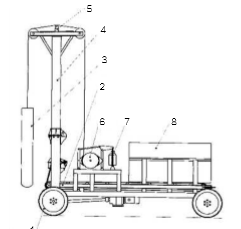 Figure 1 shows an automatic re-tamping machine with automatic feeding and automatic compaction. Two electro-hydraulic push rods are used to replace the manual operation of the brake and clutch of the sliding winch. There is a normally closed pressure switch on the top of the column. The electro-hydraulic push rod at the end of the planetary clutch of the winch has a time relay connected in series in the circuit of the electro-hydraulic push rod. In the conveyor belt circuit, There is a time relay connected in parallel. The time relay of the clutch circuit controls the lifting height of the hammer so that the weight falls at a predetermined height. After the weight falls to the ground, the pressure switch starts the winch to automatically lift the hammer. A time relay in the conveyor circuit adjusts the feed volume to match the hammering frequency. This device improves construction efficiency, reduces the number of workers, and reduces labor intensity. It can automatically record the filling amount and ramming times to facilitate supervision and ensure construction quality. When not feeding materials, the device can be used as a fully automatic dynamic compaction machine.
Figure 1 shows an automatic re-tamping machine with automatic feeding and automatic compaction. Two electro-hydraulic push rods are used to replace the manual operation of the brake and clutch of the sliding winch. There is a normally closed pressure switch on the top of the column. The electro-hydraulic push rod at the end of the planetary clutch of the winch has a time relay connected in series in the circuit of the electro-hydraulic push rod. In the conveyor belt circuit, There is a time relay connected in parallel. The time relay of the clutch circuit controls the lifting height of the hammer so that the weight falls at a predetermined height. After the weight falls to the ground, the pressure switch starts the winch to automatically lift the hammer. A time relay in the conveyor circuit adjusts the feed volume to match the hammering frequency. This device improves construction efficiency, reduces the number of workers, and reduces labor intensity. It can automatically record the filling amount and ramming times to facilitate supervision and ensure construction quality. When not feeding materials, the device can be used as a fully automatic dynamic compaction machine.
SDDC Deep Compaction Method in the Hole
Basic principles of construction methods
Super down-hole dynamic consolidation, like the DDC construction method, is also a deep foundation treatment method. This method first forms holes to a predetermined depth, and then performs layered filling and compaction from bottom to top or compaction while filling to form a dense pile body with high bearing capacity and a strongly compacted soil mass between piles, which is referred to as the SDDC method.
This method can realize two compactions of the soil between piles and has the characteristics of heavy weight of the hammer body, large diameter of the hole and pile, and high density of the pile body and the soil between the piles (pile body compaction coefficient 0.97 ~ 1.00; soil squeeze between piles). The density coefficient is 0.93-0.97), the composite foundation has a high bearing capacity (3:7 lime soil 300 ~ 350kPa; 2:8 lime soil 250 ~ 300kPa; plain soil 200 ~ 250kPa), and high construction reliability.
The difference between the SDDC construction method and the DDC construction method
The SDDC construction method is based on the DDC construction method, and performs “super kinetic energy high pressure” strong compaction on the foundation soil layer and filler from the aspects of “method” and “kinetic energy pressure”, thereby achieving an updated approach to foundation treatment and ballast soil absorption. technical effects.
SDDC method reinforcement mechanism
During the process of hole formation, the SDDC pile forces the undisturbed soil in the hole to be extruded laterally, causing the soil within a certain range around the pile to be squeezed, disturbed, and reshaped. When filling, the filler in the hole is forced to squeeze the hole laterally again. The wall causes the soil within a larger area around the pile to be squeezed, disturbed, and reshaped again. The waves and dynamic stress generated by the huge ramming energy of strong ramming repeatedly act, forcing the soil skeleton to undergo plastic deformation, thereby improving the compactness of the soil. The strength and shear strength are improved, and the deformation characteristics of the soil are improved. The bead-shaped pile body and the soil between the piles are interlocked with each other (see Figure 2).
It has a high bearing capacity and is effective in eliminating the collapsibility of loess.
The reinforcement mechanism can be summarized as follows:
① The dynamic squeezing effect of the original soil during the process of hole formation and pile formation;
② The filling and replacement effect of the pile body (including the pile body and the aggregate squeezed into the soil between the piles);
③ The hydration and hydration of quicklime. Gellation (chemical displacement).
SDDC construction method will be explained by taking a building located in the southern suburbs of Xi’an as an example. The proposed building is designed to have 353 SDDC piles. The length of the piles is based on penetrating all collapsible soil layers into the non-collapsible loess layer for 1m. The length is about 12m. According to the design requirements, the pile diameters are 1500mm and 1800mm respectively. There are two types. The foundation adopts an SDDC pile foundation, piles are placed under the columns, the pile spacing is 2.5 ~ 2.7m, and piles are added locally. The ultimate bearing capacity of a single pile corresponds to the above pile diameter design requirements of 3000kN and 3600kN respectively. The backfill material of the pile is 3:7 lime soil, and the lime soil compaction coefficient is not less than 0.96.
cast stake
Before construction, determine the control axis of the building according to the design drawings, place the exact position of the piles on the pile foundation construction work surface, and make obvious signs.
impact hole
A crane with a pile frame is used to lift a heavy hammer (an olive-shaped hammer with a diameter of about 1.4m and a weight of about 15t) to impact the hole. After the pile driver is in place, aligned, and leveled, the heavy hammer is lifted to a certain height, generally, 15 to 18m, which is equivalent to a ramming energy of 2000 to 2500kN·m, so that the hammer automatically decouples and uses its kinetic energy to rush into the soil. middle. Repeat the above operations until the hole depth reaches the design requirements.
Forced into piles
After the hole depth reaches the designed depth, the bottom of the hole is first tamped to form an enlarged head at the pile end, and then a loader is used to fill the mixed filler into the pile hole in layers and compact it. Each filling is 2m3, and 4 to 6 blows are used (using 1/2 pile length as the boundary, 4 blows are used for the lower piles, and 6 blows are used for the upper piles due to the shortened hammer drop distance) to control the pile quality. When ramming, be sure to ensure that the hammer moves freely to prevent loss of hammering energy.
In collapsible loess areas, SDDC piles save materials, have a short construction period, have low construction costs, and have obvious economic benefits. Especially in small high-rise, multi-story, civil air defense, and villa projects, the economic advantages are more prominent.
Combined use of SDDC construction method and conventional reinforced concrete cast-in-place pile construction method
Here we take five 33-story high-rise buildings located in the northern suburbs of Xi’an City as an example to illustrate. The site was originally a borrow pit for brick and tile fields. Most of the mixed-fill soil is 10.0m thick, with the deepest depth reaching 24.3m. The difference is huge. The miscellaneous fill soil is mainly construction waste, containing more bricks, tiles, and ash, and partially contains large cement blocks, floor slabs, and broken pile heads. Below the miscellaneous fill soil are loess and ancient soil, both of which are collapsible, with a burial depth of 9.00 to 22.10m. The length of the reinforced concrete pile is 37.5m, and the pile end is located in plastic, medium-compressible silty clay. The main hole-forming method is a rotary drilling rig, with a punching cone as an auxiliary method. For large concrete blocks, an SDDC sledgehammer is used to ram and expand the holes. SDDC pile positions are arranged around the cast-in-place pile positions. The SDDC method is used for pretreatment to compact large-thickness mixed-fill soil, improve the compactness of soil between piles, and eliminate the negative friction resistance on the pile side, creating conditions for pile foundation holes and improving the bearing capacity of single piles. At the point of reinforced concrete cast-in-place piles For the backfill, plain soil is used in real-time, and for the rest of the SDDC piles throughout the hall, muck is used. The diameter of SDDC piles is 1400 ~ 1800mm and the spacing between piles is 1600 ~ 2800mm. Drilling and pouring pile holes, after compaction and tamping, the compaction coefficient is greater than 0.97, the compaction coefficient is greater than 0.93, and the SDDC pile length is 10.0m ~ 17.5m. The bored piles are drilled using a rotary drilling rig, with a hole diameter of 600 to 800mm and a pile length of 37.5m. Under such a background, when constructing concrete cast-in-place piles, it is easier to form holes, the pile side resistance is improved to a certain extent, and the backfill soil layer around the pile body is stable and uniform, avoiding the shortcomings of the variable pile side resistance in the muck area. The result is an increase in the bearing capacity and relative stability of the reinforced concrete cast-in-place piles. The measured values of the single vertical ultimate bearing capacity of the reinforced concrete cast-in-place piles of the five buildings are all greater than the design value (6600kN), meeting the design requirements.
SDDC Construction Method Advantages and Disadvantages
Advantage
①Can handle all kinds of difficult foundations.
② It has the characteristics of super kinetic energy and high pressure.
③The treated foundation has “high bearing capacity”.
④ It has good performance in eliminating “sag” and “liquefaction”.
⑤ Using an olive-shaped hammer to impact the hole, the hole-forming speed is fast and the efficiency is high.
⑥ The depth of the foundation to be treated is large.
⑦ Local materials can be used. All inorganic solid materials such as soil, sand and gravel, broken bricks, concrete blocks, construction waste, industrial waste, and their mixtures can be used.
⑧There is no need to collect soil when forming the hole. Compared with other methods such as bored piles, this method can save steel and cement, reduce the transportation of soil and mud when forming the hole, and reduce the project cost.
⑨ It can be used in conjunction with conventional reinforced concrete cast-in-place pile construction methods to improve the bearing capacity of a single pile and be used for the foundation of high-rise buildings.
⑩ The construction site is clean, without mud pollution, has little impact on the surrounding environment, and has low construction pollution. A large amount of waste materials and garbage can be consumed.
Shortcoming
Due to the large size of the equipment and the heavy weight of the rammer, construction in some noise- and vibration-sensitive areas will be affected.
New technology for automatic decoupling in SDDC method construction To eliminate the hidden dangers of manually pulling the rope to decouple the weight, which is a cumbersome and unsafe technology, a new automatic decoupling technology has been developed that is easy to operate, safe, reliable and relatively low-cost.
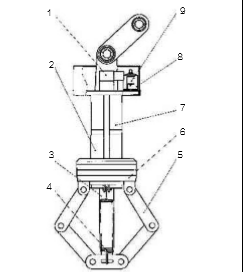
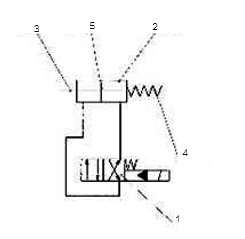
Figure 3 shows an automatic hooking (unhooking) device for a heavy hammer operated by a remote control. The device is mainly composed of a counterweight, a cylinder, a spring, and a four-link rod. It is characterized by two cavities of a double-extension cylinder and a two-position solenoid valve. The oil pipe forms a closed oil circuit. The two-position solenoid valve is switched on by the remote control receiver. The counterweight is pressed above the four-link rod. One end of the spring is fixed below the four-link rod, and the other end is fixed on the outer wall of the oil cylinder. The four-link rod The upper part moves up and down along the axis of the oil cylinder and the lower part is fixed on the piston rod of the oil cylinder.
It can be seen from the hydraulic schematic diagram in Figure 4: In the closed oil circuit, when the solenoid valve is in the on position, the upper and lower chambers of the oil cylinder are connected, and the hydraulic oil can flow freely from one chamber to the other. When the solenoid valve is in the cut-off position, the oil path between the upper and lower chambers is cut off, and the upper and lower chambers are not connected. When the oil circuit between the upper and lower chambers is connected, the piston rod can move, extend, or contract under the action of external force; when the oil circuit between the upper and lower chambers is cut off, the piston rod maintains its original extended or contracted position even if there is an external force. constant.
It can be seen from Figure 3 that the position of the piston rod determines the state of the four-links: when the lower end of the double-extended piston rod extends, the four-links extend longitudinally and contract transversely; when the lower end of the piston rod contracts, the four-links shrink longitudinally and extend transversely. When in use, the device is inserted into the inner cone-shaped hanging bucket of the weight. Through the device’s weight, the four connecting rods lift the counterweight. After insertion, under the gravity of the counterweight, the four connecting rods extend laterally and hook the hanging bucket. , lift the hammer. When the weight is raised to a predetermined height, the solenoid valve is operated to connect the oil circuit. Once the oil circuit is connected, the four-link rod overcomes the tension of the spring under the strong gravity of the weight, causing the lower end of the piston rod to extend. It extends longitudinally and contracts transversely, and the weight falls immediately, and the spring resets the piston rod, thereby realizing automatic hook unhooking.
Features and advantages of the new automatic decoupling technology:
①Remote control operation, automatic decoupling, and dropping hammer for hole tamping.
② The ramming kinetic energy is increased, and the quality of hole and column formation is guaranteed. The single-unit work efficiency is improved and the construction period is effectively shortened. The labor intensity is reduced and the safety of construction personnel is guaranteed. The automatic decoupling device has a simple, reliable, and durable structure.
Social and Economic Benefit Analysis and Evaluation
In terms of economic benefits, the SDDC method has a simple construction process. It uses an olive-shaped hammer to impact the hole. The hole-forming speed is fast and the efficiency is high. Its single pile bearing capacity is large and the effect of eliminating collapsibility is significant. Moreover, this method can use local materials. Inorganic solid materials such as soil, sand and gravel, broken bricks, concrete blocks, construction waste, industrial waste, and their mixtures can be used (this project uses 3:7 lime soil as pile filler), and there is no need to collect soil or drill when forming the hole. Compared with other methods such as cast-in-hole piles, this method can save steel and cement, reduce the transportation of soil and mud during foundation pit excavation and hole formation, reduce project costs, and greatly save project expenses.
In terms of social benefits, the SDDC construction method has a clean construction site, no mud pollution, little impact on the surrounding environment, and low construction pollution. Moreover, this method can consume a large amount of waste materials and garbage.
Therefore, the SDDC construction method is an ideal foundation treatment method, both in terms of economic and technical aspects and social benefits.
Summary
Collapsible loess is relatively common in my country, and it is recommended that the SDDC method be used to treat foundations nationwide. When dealing with problems such as “miscellaneous filling”, “weakness”, “collapse”, “liquefaction” and “expansion”, there are still many problems such as “corrosive media”, “groundwater”, “large thickness” of construction waste and high-filling of rocks. When treating difficult foundations such as squares, traditional foundation treatment methods have unsatisfactory results or high engineering costs, but the SDDC method can achieve better technical results and economic benefits. When using the SDDC method to treat foundations, waste soil, and construction waste can be used As a filler, construction materials are saved and environmental pollution is reduced. The SDDC method has a good squeezing effect on the soil around the pile, which increases the bearing capacity of the soil around the pile, reduces the compressibility of the soil, and has a good effect in eliminating collapsibility, and the treatment depth is Deeper.
Thank You!

